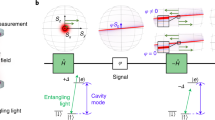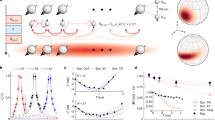Abstract
Time-reversed evolution has substantial implications in physics, including applications in refocusing of classical waves or spins and fundamental studies such as quantum information scrambling. In quantum metrology, nonlinear interferometry based on time-reversal protocols supports entanglement-enhanced measurements without requiring low-noise detection. Despite the broad interest in this topic, it remains challenging to reverse the quantum dynamics of an interacting many-body system, which is typically realized by an (effective) sign flip of the system’s Hamiltonian. Here we present an approach that is broadly applicable to cyclic systems for implementing nonlinear interferometry without invoking time reversal. As time-reversed dynamics drives a system back to its starting point, we propose to accomplish the same by forcing the system to travel along a ‘closed loop’ instead of explicitly tracing back its antecedent path. Utilizing the quasiperiodic spin mixing dynamics in a three-mode 87Rb atomic spinor condensate, we implement such a closed-loop nonlinear interferometer and achieve a metrological gain of \(5.0{1}_{-0.76}^{+0.76}\) decibels over the classical limit for a total of 26,500 atoms. Our approach unlocks the potential of nonlinear interferometry by allowing the dynamics to penetrate into the deep nonlinear regime, which gives rise to highly entangled non-Gaussian states.
This is a preview of subscription content, access via your institution
Access options
Access Nature and 54 other Nature Portfolio journals
Get Nature+, our best-value online-access subscription
$29.99 / 30 days
cancel any time
Subscribe to this journal
Receive 12 print issues and online access
$209.00 per year
only $17.42 per issue
Buy this article
- Purchase on Springer Link
- Instant access to full article PDF
Prices may be subject to local taxes which are calculated during checkout



Similar content being viewed by others
Data availability
Source data (including raw experimental data) are provided with this paper. Source data for Supplementary Figs. 5 and 6 are given in Supplementary Data 1 and 2. All other data that support the plots within this paper and other findings of this study are available from the corresponding author upon reasonable request.
Code availability
The codes are available from the corresponding author upon reasonable request.
References
Eddington, A. S. The Nature of the Physical World (Cambridge Univ. Press, 1928).
Fink, M. et al. Time-reversed acoustics. Rep. Prog. Phys. 63, 1933–1995 (2000).
Lerosey, G. et al. Time reversal of electromagnetic waves. Phys. Rev. Lett. 92, 193904 (2004).
Lerosey, G., de Rosny, J., Tourin, A. & Fink, M. Focusing beyond the diffraction limit with far-field time reversal. Science 315, 1120–1122 (2007).
Hahn, E. L. Spin echoes. Phys. Rev. 80, 580–594 (1950).
Kurnit, N. A., Abella, I. D. & Hartmann, S. R. Observation of a photon echo. Phys. Rev. Lett. 13, 567–568 (1964).
Shenker, S. H. & Stanford, D. Black holes and the butterfly effect. J. High Energy Phys. 2014, 67 (2014).
Gärttner, M. et al. Measuring out-of-time-order correlations and multiple quantum spectra in a trapped-ion quantum magnet. Nat. Phys. 13, 781–786 (2017).
Landsman, K. A. et al. Verified quantum information scrambling. Nature 567, 61–65 (2019).
Lewis-Swan, R. J., Safavi-Naini, A., Bollinger, J. J. & Rey, A. M. Unifying scrambling, thermalization and entanglement through measurement of fidelity out-of-time-order correlators in the Dicke model. Nat. Commun. 10, 1581 (2019).
Quan, H. T., Song, Z., Liu, X. F., Zanardi, P. & Sun, C. P. Decay of Loschmidt echo enhanced by quantum criticality. Phys. Rev. Lett. 96, 140604 (2006).
Nie, X. et al. Experimental observation of equilibrium and dynamical quantum phase transitions via out-of-time-ordered correlators. Phys. Rev. Lett. 124, 250601 (2020).
Lewis-Swan, R. J., Muleady, S. R. & Rey, A. M. Detecting out-of-time-order correlations via quasiadiabatic echoes as a tool to reveal quantum coherence in equilibrium quantum phase transitions. Phys. Rev. Lett. 125, 240605 (2020).
Davis, E., Bentsen, G. & Schleier-Smith, M. Approaching the Heisenberg limit without single-particle detection. Phys. Rev. Lett. 116, 053601 (2016).
Fröwis, F., Sekatski, P. & Dür, W. Detecting large quantum Fisher information with finite measurement precision. Phys. Rev. Lett. 116, 090801 (2016).
Macrì, T., Smerzi, A. & Pezzè, L. Loschmidt echo for quantum metrology. Phys. Rev. A 94, 010102 (2016).
Giovannetti, V., Lloyd, S. & Maccone, L. Quantum-enhanced measurements: beating the standard quantum limit. Science 306, 1330–1336 (2004).
Pezzè, L., Smerzi, A., Oberthaler, M. K., Schmied, R. & Treutlein, P. Quantum metrology with nonclassical states of atomic ensembles. Rev. Mod. Phys. 90, 035005 (2018).
Gross, C., Zibold, T., Nicklas, E., Esteve, J. & Oberthaler, M. K. Nonlinear atom interferometer surpasses classical precision limit. Nature 464, 1165–1169 (2010).
Riedel, M. F. et al. Atom-chip-based generation of entanglement for quantum metrology. Nature 464, 1170–1173 (2010).
Lücke, B. et al. Twin matter waves for interferometry beyond the classical limit. Science 334, 773–776 (2011).
Hosten, O., Engelsen, N. J., Krishnakumar, R. & Kasevich, M. A. Measurement noise 100 times lower than the quantum-projection limit using entangled atoms. Nature 529, 505–508 (2016).
Luo, X.-Y. et al. Deterministic entanglement generation from driving through quantum phase transitions. Science 355, 620–623 (2017).
Zou, Y.-Q. et al. Beating the classical precision limit with spin-1 Dicke states of more than 10,000 atoms. Proc. Natl Acad. Sci. USA 115, 6381–6385 (2018).
Pedrozo-Peñafiel, E. et al. Entanglement on an optical atomic-clock transition. Nature 588, 414–418 (2020).
Bao, H. et al. Spin squeezing of 1011 atoms by prediction and retrodiction measurements. Nature 581, 159–163 (2020).
Hume, D. B. et al. Accurate atom counting in mesoscopic ensembles. Phys. Rev. Lett. 111, 253001 (2013).
Qu, A., Evrard, B., Dalibard, J. & Gerbier, F. Probing spin correlations in a Bose–Einstein condensate near the single-atom level. Phys. Rev. Lett. 125, 033401 (2020).
Hüper, A. et al. Number-resolved preparation of mesoscopic atomic ensembles. New J. Phys. https://doi.org/10.1088/1367-2630/abd058 (2020).
Hudelist, F. et al. Quantum metrology with parametric amplifier-based photon correlation interferometers. Nat. Commun. 5, 3049 (2014).
Manceau, M., Leuchs, G., Khalili, F. & Chekhova, M. Detection loss tolerant supersensitive phase measurement with an SU(1,1) interferometer. Phys. Rev. Lett. 119, 223604 (2017).
Linnemann, D. et al. Quantum-enhanced sensing based on time reversal of nonlinear dynamics. Phys. Rev. Lett. 117, 013001 (2016).
Linnemann, D. et al. Active SU(1,1) atom interferometry. Quantum Sci. Technol. 2, 044009 (2017).
Hosten, O., Krishnakumar, R., Engelsen, N. J. & Kasevich, M. A. Quantum phase magnification. Science 352, 1552–1555 (2016).
Burd, S. C. et al. Quantum amplification of mechanical oscillator motion. Science 364, 1163–1165 (2019).
Law, C. K., Pu, H. & Bigelow, N. P. Quantum spins mixing in spinor Bose–Einstein condensates. Phys. Rev. Lett. 81, 5257–5261 (1998).
Yurke, B., McCall, S. L. & Klauder, J. R. SU(2) and SU(1,1) interferometers. Phys. Rev. A 33, 4033–4054 (1986).
Gabbrielli, M., Pezzè, L. & Smerzi, A. Spin-mixing interferometry with Bose–Einstein condensates. Phys. Rev. Lett. 115, 163002 (2015).
Szigeti, S. S., Lewis-Swan, R. J. & Haine, S. A. Pumped-up SU(1,1) interferometry. Phys. Rev. Lett. 118, 150401 (2017).
Chang, M.-S., Qin, Q., Zhang, W., You, L. & Chapman, M. S. Coherent spinor dynamics in a spin-1 Bose condensate. Nat. Phys. 1, 111–116 (2005).
Zhang, W., Zhou, D. L., Chang, M. S., Chapman, M. S. & You, L. Coherent spin mixing dynamics in a spin-1 atomic condensate. Phys. Rev. A. 72, 013602 (2005).
Gerving, C. S. et al. Non-equilibrium dynamics of an unstable quantum pendulum explored in a spin-1 Bose–Einstein condensate. Nat. Commun. 3, 1169 (2012).
Rauer, B. et al. Recurrences in an isolated quantum many-body system. Science 360, 307–310 (2018).
Schweigler, T. et al. Decay and recurrence of non-Gaussian correlations in a quantum many-body system. Nat. Phys. 17, 559–563 (2021).
Gessner, M., Smerzi, A. & Pezzè, L. Metrological nonlinear squeezing parameter. Phys. Rev. Lett. 122, 090503 (2019).
Strobel, H. et al. Fisher information and entanglement of non-Gaussian spin states. Science 345, 424–427 (2014).
Walmsley, I. & Rabitz, H. Quantum physics under control. Phys. Today 56, 43–49 (2003).
Carleo, G. et al. Machine learning and the physical sciences. Rev. Mod. Phys. 91, 045002 (2019).
Guo, S.-F. et al. Faster state preparation across quantum phase transition assisted by reinforcement learning. Phys. Rev. Lett. 126, 060401 (2021).
Lücke, B. et al. Detecting multiparticle entanglement of dicke states. Phys. Rev. Lett. 112, 155304 (2014).
Hamley, C. D., Gerving, C. S., Hoang, T. M., Bookjans, E. M. & Chapman, M. S. Spin-nematic squeezed vacuum in a quantum gas. Nat. Phys. 8, 305–308 (2012).
Acknowledgements
We thank F. Chen, Y. Q. Zou, J. L. Yu and M. Xue for helpful discussions. This work is supported by the National Natural Science Foundation of China (NSFC; grant numbers 11654001, U1930201, 91636213 and 91836302), by the Key-Area Research and Development Program of GuangDong Province (grant number 2019B030330001) and by the National Key R&D Program of China (grant nnumbers 2018YFA0306504 and 2018YFA0306503). L.-N.W. acknowledges support from the Deutsche Forschungsgemeinschaft (DFG) via grant no. 163436311.
Author information
Authors and Affiliations
Contributions
L.-N.W. and L.Y. conceived this study. Q.L., J.-H.C., T.-W.M. and S.-F.G. performed the experiment and analysed the data. Q.L., L.-N.W. and X.-W.L. conducted the numerical simulations. Q.L., L.-N.W., M.K.T. and L.Y. wrote the paper.
Corresponding author
Ethics declarations
Competing interests
The authors declare no competing interests.
Additional information
Peer review information Nature Physics thanks Paul Griffin and the other, anonymous, reviewer(s) for their contribution to the peer review of this work.
Publisher’s note Springer Nature remains neutral with regard to jurisdictional claims in published maps and institutional affiliations.
Extended data
Extended Data Fig. 1 Calibration of quadratic Zeeman shift qt for phase imprinting.
For qt much larger than spin-exchange rate ∣c2∣, the state will accumulate a spinor phase proportional to interrogation time τ without undergoing noticeable population changes in the three Zeeman sublevels. Following the short-term spin dynamics for 5 ms at q ≈ ∣c2∣, the encoded phase is transformed into oscillations of 〈ρ0(τ)〉 at frequency 2qt. Blue (orange) dots denote data points measured at microwave detuning of Δ = − 3.1(3.1) MHz for the ‘dressing’ (‘pre-dressing’) pulse. Fitting them with sinusoidal function Eq. (2) in Methods enables the value of qt to be determined. Solid lines display the corresponding fitting curves.
Extended Data Fig. 2 Implementation of the three-mode linear interferometer.
a, The experimental sequence consists of four steps: initialization of the system in the polar state, linear path splitting with π/4 Rabi rotation around collective spin Lx, phase encoding with generator − N0/2 (N0 denotes the number of atoms in the \(\left|1,0\right\rangle\) component), and linear path recombining with π/2 rotation around − Ly. The dependence of magnetization Lz/N on the phase ϕ is measured in the end. b, Data in the main figure shows results averaged over three measurements, while the solid line is the fitted sinusoidal function curve. Two horizontal black dashed lines denote the bounds of ± 1. The inset presents measured mean value and fluctuation of Lz/N in the vicinity of ϕ = 0 from 50 repetitions. Error bars (invisible in the main figure) denote one standard deviation and the spread of shaded area corresponds to the quantum projection noise for ideal atomic coherent state. Solid line in the inset denotes the result from a linear fit, which is used to calculate the metrological gain.
Supplementary information
Supplementary Information
Supplementary Figs. 1–6 and Discussion.
Supplementary Data 1
Experimental data in Supplementary Fig. 5.
Supplementary Data 2
Experimental data in Supplementary Fig. 6.
Source data
Source Data Fig. 1
Statistical source data
Source Data Fig. 2
Statistical source data
Source Data Fig. 3
Statistical source data
Source Data Extended Data Fig. 1
Statistical source data
Source Data Extended Data Fig. 2
Statistical source data
Rights and permissions
About this article
Cite this article
Liu, Q., Wu, LN., Cao, JH. et al. Nonlinear interferometry beyond classical limit enabled by cyclic dynamics. Nat. Phys. 18, 167–171 (2022). https://doi.org/10.1038/s41567-021-01441-7
Received:
Accepted:
Published:
Issue Date:
DOI: https://doi.org/10.1038/s41567-021-01441-7
This article is cited by
-
Stochastic resonance of spinor condensates in optical cavity
Science China Physics, Mechanics & Astronomy (2024)
-
Cavity-enhanced metrology in an atomic spin-1 Bose–Einstein condensate
Frontiers of Physics (2024)
-
Quantum-enhanced sensing by echoing spin-nematic squeezing in atomic Bose–Einstein condensate
Nature Physics (2023)
-
Measure in circles
Nature Physics (2022)



